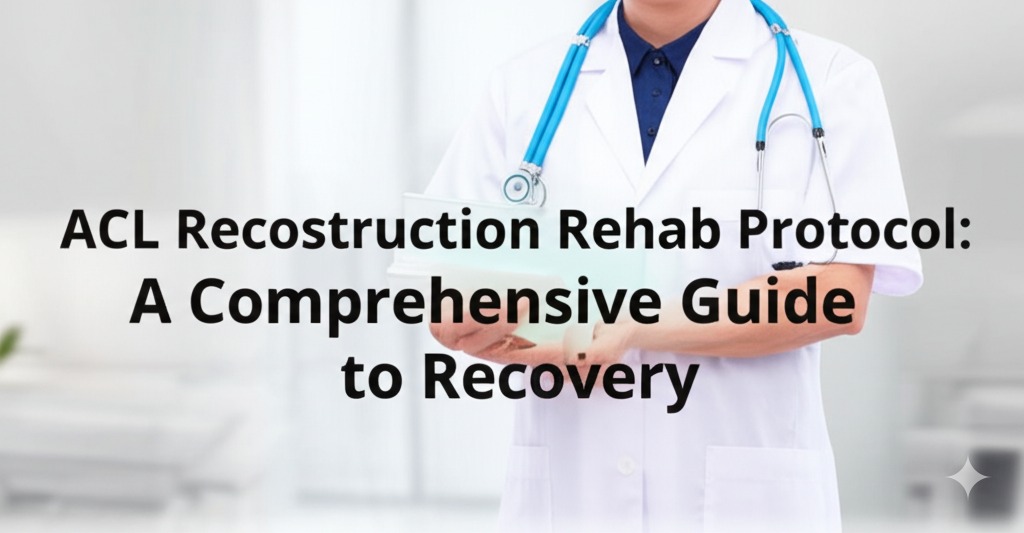An anterior cruciate ligament (ACL) injury can be a major setback for athletes and active individuals alike. Whether you’ve had ACL surgery for a torn ligament or are supporting someone through their recovery, understanding the rehabilitation process is key to a successful outcome. The ACL reconstruction rehab protocol is designed to ensure a safe and effective recovery, minimizing the risk of re-injury and helping the patient regain full function. In this article, we will break down the essential stages of ACL rehab, highlight the importance of each step, and offer tips for a smooth recovery.
What is ACL Reconstruction Rehab?
ACL reconstruction surgery is a common procedure performed to repair a torn ACL, which is crucial for knee stability. The rehab process following this surgery is just as important as the surgery itself. Proper rehabilitation ensures that the knee regains strength, flexibility, and function so that the individual can safely return to their daily activities and sports.
The rehab protocol typically involves a combination of physical therapy, exercises, and other treatments to gradually rebuild strength and mobility in the knee. The rehabilitation process is divided into several stages, each with specific goals and exercises to facilitate healing.
Key Stages of ACL Reconstruction Rehab
Stage 1: Initial Recovery (0-2 Weeks)
In the first two weeks following surgery, the focus is on reducing swelling, managing pain, and beginning gentle movement. During this phase, patients should aim to:
- Rest the knee and avoid putting weight on it.
- Ice the knee regularly to manage swelling.
- Elevate the leg to reduce inflammation.
- Perform gentle range-of-motion exercises to prevent stiffness.
At this stage, it’s crucial to follow your surgeon’s and physical therapist’s recommendations closely. They may recommend crutches or a knee brace to limit movement while the tissues begin to heal.
Stage 2: Early Rehab (2-6 Weeks)
As healing progresses, patients will start to focus more on improving knee function and strength. Goals during this stage include:
- Regaining full knee extension: Achieving full straightening of the knee is essential for proper function.
- Building basic strength: Strengthening the quadriceps and hamstrings helps support the knee joint.
- Increasing range of motion: Flexion exercises to restore the knee’s ability to bend.
Exercises to try:
- Quad sets: Tighten the quadriceps while keeping the leg straight.
- Hamstring curls: Gentle hamstring exercises to improve flexibility.
- Heel slides: Slide your heel towards your buttocks to improve knee flexion.
This stage often includes light weight-bearing activities like walking with crutches, progressing to partial weight-bearing as tolerated.
Stage 3: Intermediate Rehab (6-12 Weeks)
At this point, patients are typically able to bear full weight on the affected leg. The goal of this stage is to enhance strength, flexibility, and balance while progressively increasing the intensity of exercises.
- Strength training: Focusing on strengthening the muscles around the knee, including the quadriceps, hamstrings, and calf muscles.
- Proprioception exercises: Working on balance and coordination to improve stability.
- Cardiovascular conditioning: Low-impact activities like stationary cycling and swimming may be introduced.
Exercises to try:
- Leg presses: Using a leg press machine to strengthen the quadriceps and hamstrings.
- Step-ups: Strengthening the quads and glutes by stepping onto a low platform.
- Balance drills: Standing on one leg to improve stability.
Stage 4: Advanced Rehab (3-6 Months)
This stage focuses on preparing the knee for higher-impact activities and sports. The goals include improving strength, agility, and endurance, with a focus on functional movements that simulate real-life activities.
- Plyometric exercises: Low-impact jumps and hops to build strength and agility.
- Running progression: Gradually introducing running, starting with light jogging and progressing to full running.
Exercises to try:
- Lunges: Walking or stationary lunges to enhance strength and coordination.
- Box jumps: Jumping onto a box or step to improve explosive strength.
- Agility drills: Lateral movements and cone drills to improve speed and agility.
Stage 5: Return to Sport (6-12 Months)
The final stage of ACL reconstruction rehab is aimed at returning to sport and high-level activity. By this time, strength, balance, and functional mobility should be near or at pre-injury levels. The key focus here is:
- Functional testing: Ensuring the knee is capable of handling sport-specific movements without compromising safety.
- Sport-specific drills: Gradually integrating drills that mimic the movements required for your sport.
At this stage, it is crucial to work closely with your physical therapist and coach to ensure you’re ready to return to play. Returning to sports too soon can increase the risk of re-injury.
Tips for a Successful ACL Rehab
- Be patient: ACL rehab is a long and challenging process. It may take up to a year for some individuals to fully recover. Progress may seem slow, but consistency is key.
- Follow your physical therapist’s instructions: Each rehab protocol is tailored to the individual’s needs. Stick to the program designed for your specific condition.
- Don’t rush: Returning to sport or intense activity before you’re fully healed can lead to re-injury. Take your time and ensure you’re fully prepared.
- Stay active: While you may need to avoid high-impact activities early on, maintaining overall fitness through low-impact exercises can aid recovery.
Conclusion
The ACL reconstruction rehab protocol is a comprehensive process that requires dedication, patience, and consistency. By following the prescribed stages of rehabilitation, individuals can recover fully and safely return to their daily activities and sports. Remember, every patient’s recovery is unique, so always work closely with your healthcare team to adjust the rehab process as needed.
If you or someone you know is undergoing ACL surgery, don’t hesitate to seek professional guidance. The right rehab plan will help ensure a smoother and more effective recovery. Take control of your recovery today and commit to the process!

Kallie Snyder is an author at Stonegate Health Rehab, providing valuable insights, recovery guidance, and rehab resources to help individuals achieve better health and well-being.
